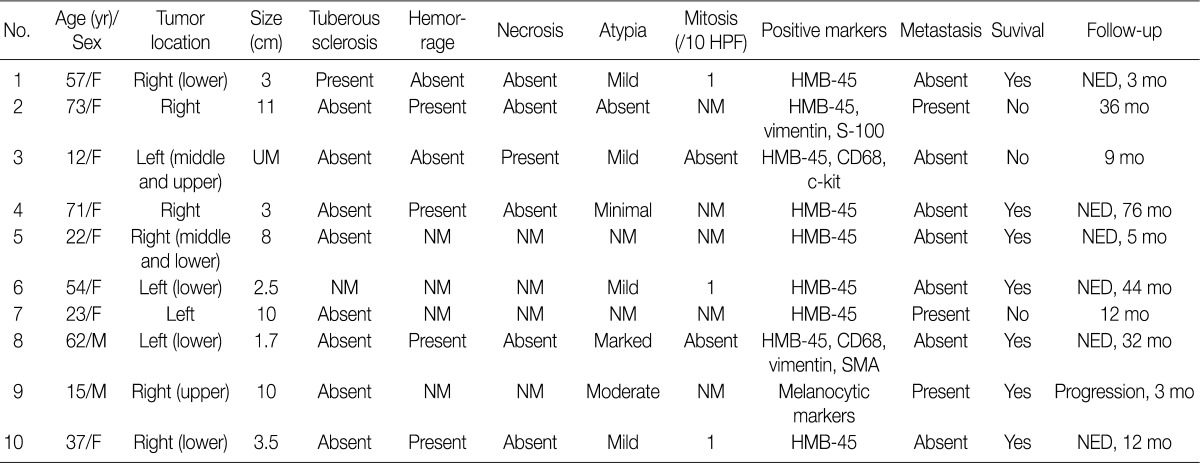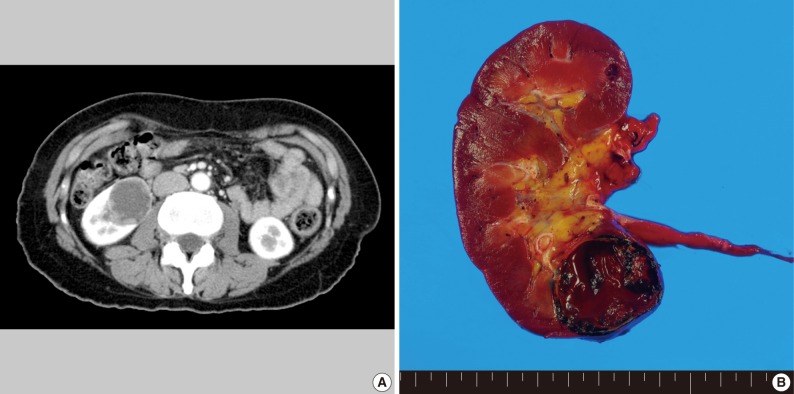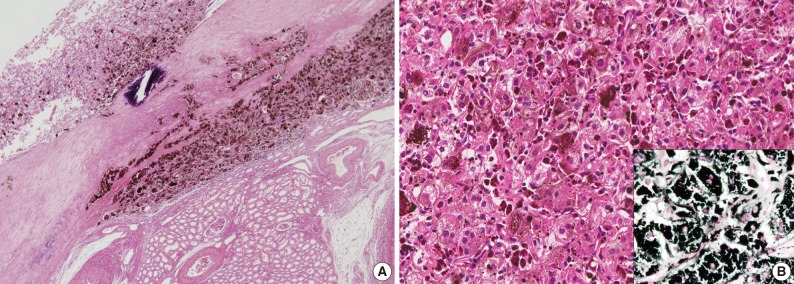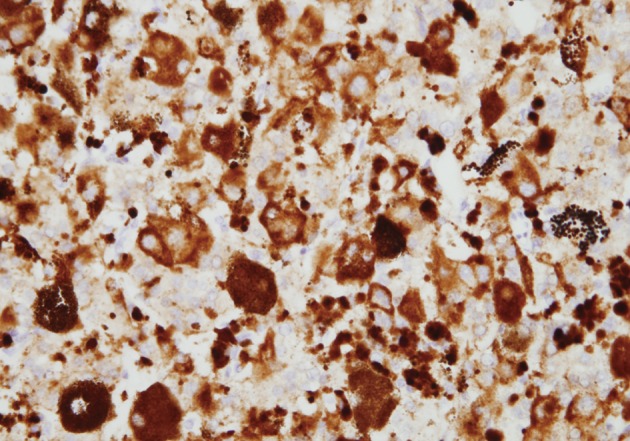Articles
- Page Path
- HOME > J Pathol Transl Med > Volume 46(5); 2012 > Article
-
Case Report
Pigmented Perivascular Epithelioid Cell Tumor (PEComa) of the Kidney: A Case Report and Review of the Literature - Hyeyoon Chang, Wonkyung Jung, Youngran Kang, Woon Yong Jung
-
Korean Journal of Pathology 2012;46(5):499-502.
DOI: https://doi.org/10.4132/KoreanJPathol.2012.46.5.499
Published online: October 25, 2012
Department of Pathology, Korea University Guro Hospital, Korea University College of Medicine, Seoul, Korea.
- Corresponding Author: Woon Yong Jung, M.D. Department of Pathology, Korea University Guro Hospital, Korea University College of Medicine, 148 Gurodong-ro, Guro-gu, Seoul 152-703, Korea. Tel: +82-2-2626-1485, Fax: +82-2-2626-1486, pathjwy@gmail.com
• Received: April 7, 2011 • Revised: January 12, 2012 • Accepted: January 31, 2012
© 2012 The Korean Society of Pathologists/The Korean Society for Cytopathology
This is an Open Access article distributed under the terms of the Creative Commons Attribution Non-Commercial License (http://creativecommons.org/licenses/by-nc/3.0) which permits unrestricted non-commercial use, distribution, and reproduction in any medium, provided the original work is properly cited.
Figure & Data
References
Citations
Citations to this article as recorded by 

- Tumor de células epitelioides perivasculares (PEComa) primário do rim: uma revisão sistemática
Eric Lima Freitas Mota, Mariana Macambira Noronha, Letícia Pinheiro Amorim, João Luiz Lima Pinheiro, Eduarda Severo Alvarenga, Paulo Eduardo de Oliveira, Fabrícia Cardoso Marques, Emmanuel Apollo de Macedo Ferreira
Cuadernos de Educación y Desarrollo.2024; 16(12 Edição ): e6498. CrossRef - Malignant Pigmented Epithelioid Angiomyolipoma of the Kidney in a Child with Tuberous Sclerosis Complex
Thu Dang Anh Phan, Nhi Thuy To, Diem Thi Nhu Pham
Fetal and Pediatric Pathology.2023; 42(2): 285. CrossRef - Perivascular epithelioid cell tumor (PEComa) of the cystic duct
Takeshi Okamoto, Takashi Sasaki, Yu Takahashi, Manabu Takamatsu, Hiroaki Kanda, Makiko Hiratsuka, Masato Matsuyama, Masato Ozaka, Naoki Sasahira
Clinical Journal of Gastroenterology.2023; 16(1): 87. CrossRef - PEComa of the Adrenal Gland
Craig B. Wakefield, Peter M. Sadow, Jason L. Hornick, Christopher D.M. Fletcher, Justine A. Barletta, William J. Anderson
American Journal of Surgical Pathology.2023; 47(11): 1316. CrossRef - Recurrence of Pigmented Epithelioid Angiomyolipoma of the Kidney With Xp11 Translocation: A Case Report
Mahmoud D Srour, Andrew Harris
Cureus.2023;[Epub] CrossRef - Pigmented perivascular epithelioid cell tumor (PEComa) arising from kidney
Hexi Du, Jun Zhou, Lingfan Xu, Cheng Yang, Li Zhang, Chaozhao Liang
Medicine.2016; 95(44): e5248. CrossRef - PEComas of the kidney and of the genitourinary tract
Guido Martignoni, Maurizio Pea, Claudia Zampini, Matteo Brunelli, Diego Segala, Giuseppe Zamboni, Franco Bonetti
Seminars in Diagnostic Pathology.2015; 32(2): 140. CrossRef - Pigmented Perivascular Epithelioid Cell Tumor of the Skin
Pooja Navale, Masoud Asgari, Sheng Chen
The American Journal of Dermatopathology.2015; 37(11): 866. CrossRef - Clear Cell Melanoma: A Cutaneous Clear Cell Malignancy
Maria A. Pletneva, Aleodor Andea, Nallasivam Palanisamy, Bryan L. Betz, Shannon Carskadon, Min Wang, Rajiv M. Patel, Douglas R. Fullen, Paul W. Harms
Archives of Pathology & Laboratory Medicine.2014; 138(10): 1328. CrossRef - Extrapulmonary Lymphangioleiomyoma: Clinicopathological Analysis of 4 Cases
Dae Hyun Song, In Ho Choi, Sang Yun Ha, Kang Min Han, Jae Jun Lee, Min Eui Hong, Yoon-La Choi, Kee-Taek Jang, Sang Yong Song, Chin A Yi, Joungho Han
Korean Journal of Pathology.2014; 48(3): 188. CrossRef
Pigmented Perivascular Epithelioid Cell Tumor (PEComa) of the Kidney: A Case Report and Review of the Literature



Fig. 1 (A) Abdominal computed tomography. A well-demarcated cystic tumor, 3.5 cm in diameter, on the right kidney is noted. (B) The tumor is a black-pigmented mass with cystic change and is filled with blood clots and thick brownish fluid.
Fig. 2 (A) The tumor is well demarcated from the renal parenchyma and partially encapsulated by a thick fibrous capsule. (B) The tumor is composed of sheets of large polygonal tumor cells with eosinophilic or clear cytoplasm. The brown pigments in the cytoplasm strongly reacts with Fontana-Masson stain (inset).
Fig. 3 The tumor cells strongly reacted with human melanoma black-45 monoclonal antibody.
Fig. 1
Fig. 2
Fig. 3
Pigmented Perivascular Epithelioid Cell Tumor (PEComa) of the Kidney: A Case Report and Review of the Literature

Table 1 Clinical and pathologic features of pigmented PEComa of the kidney3-6,8-11
HPF, high power field; F, female; M, male; HMB-45, human melanoma black-45; NED, no evidence of disease; NM, not mentioned; UM, unmeasurable; SMA, smooth muscle actin.

 E-submission
E-submission




 PubReader
PubReader Cite this Article
Cite this Article




